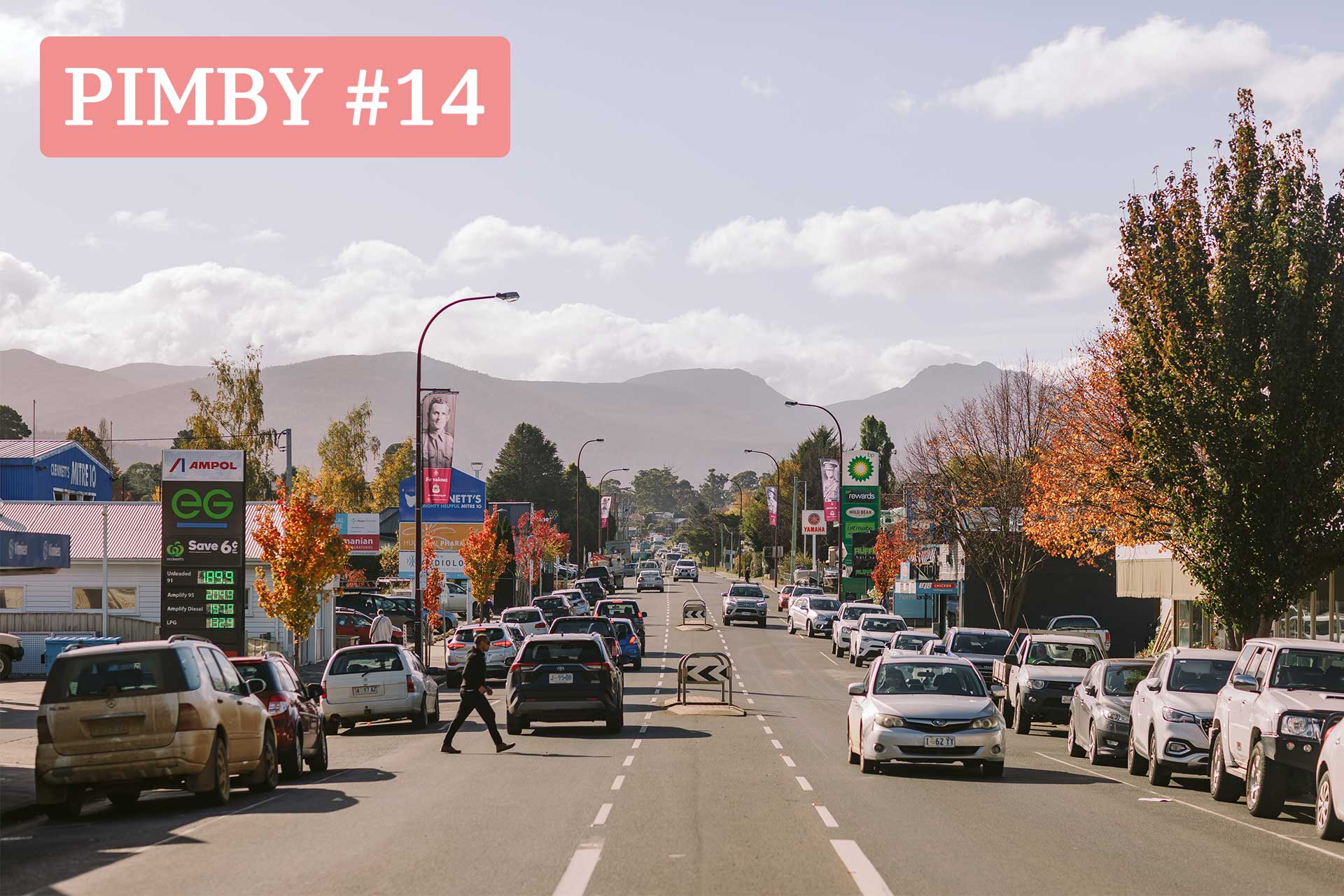wrapped up in July. The strategy aims to help Tasmania cut emissions
from transport and industry, strengthen our energy security, and make the most of our renewable electricity advantage.
In this PIMBY article, we’re examining clean fuels: What they are, why they matter for Tasmania, and how they might help cut emissions. We’re also going to spend a little time unpacking the challenges related to clean fuels, and whether they can be an opportunity for Tasmania.
So what are clean fuels?
‘Clean fuels’ is a catch-all term for fuels that produce fewer greenhouse gas (GHG) emissions across their lifecycle than traditional fossil fuels. This captures a range of fuels that have varying levels of emissions, come from different sources, and suit different uses. Some of the most common types are
biodiesel, renewable diesel and sustainable aviation fuels, which can be used to replace or as blends in heavy transport, aviation, and marine freight, as well as industrial processes and home heating.
Some clean fuels are already available in Tasmania, such as
E10, an ethanol/petrol blend that you can find at many petrol stations. But the real game-changer will be “drop-in” fuels like renewable diesel,
which can The
Tasmanian Government defines “clean fuels” as ‘gases, liquids or solids that have lower greenhouse gas emissions than
fossil fuels across their entire lifecycle’.
completely replace fossil fuels. They’re expected to be crucial in
helping reduce emissions in areas that are hardest to electrify, such as road freight, aviation and maritime applications.
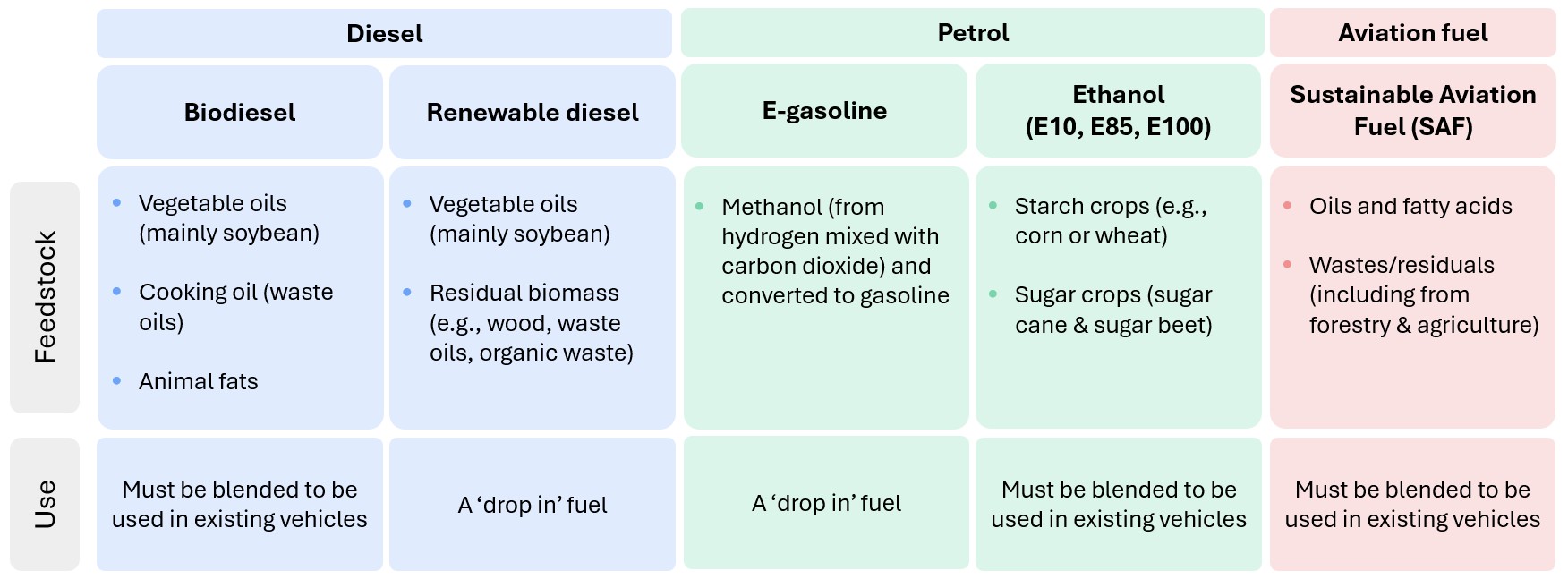
Low-carbon liquid fuels can be produced in a few ways. Because it is likely to be an important player into the future, we want to focus on renewable (or green) diesel for this PIMBY. It can be made from a wide range of biomass –including vegetable oil and agricultural waste (such as
vegetable oil, animal fat and cooking oil). The usual production process sees the
biomass purified, treated with hydrogen under high pressure to remove oxygen, and chemically processed into a liquid fuel that can be used in any diesel tank.
HVO100 is a type of renewable diesel – so it's made through this same process, but typically uses
vegetable oil (or made from
used oils and fats) as its feedstock.
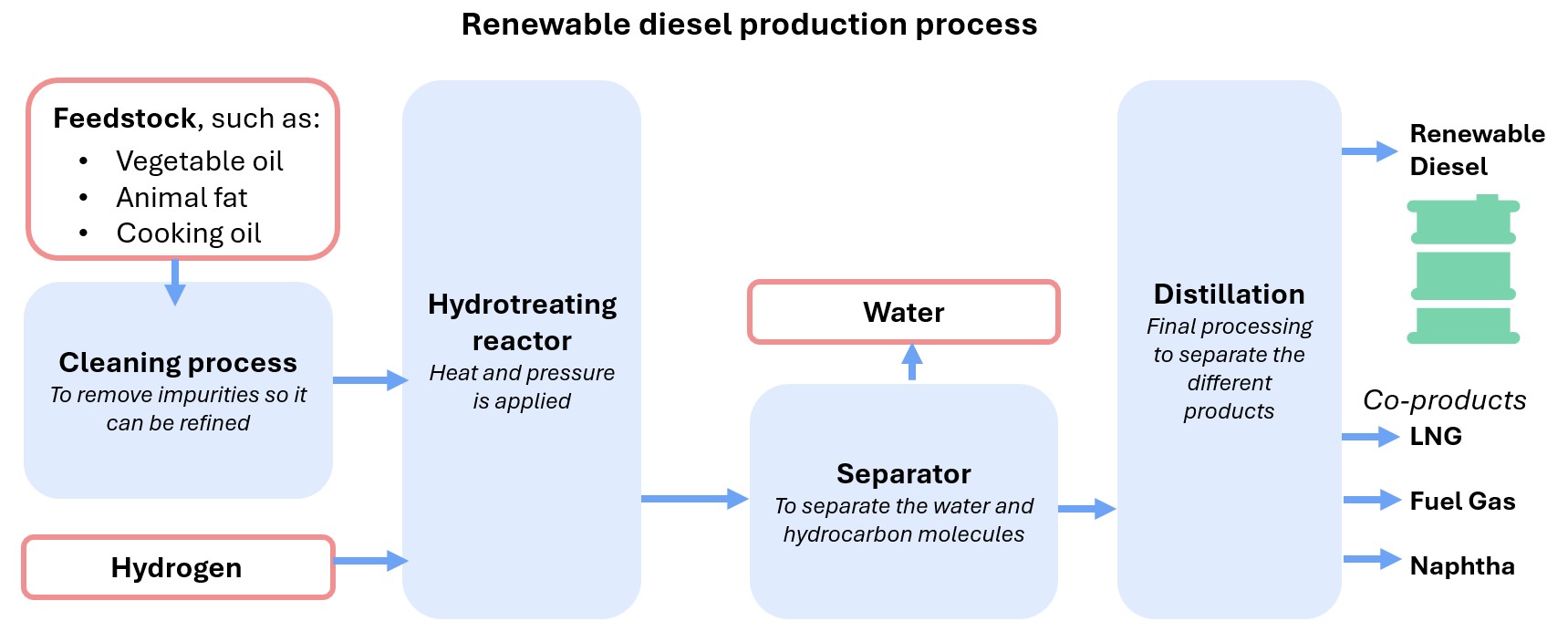
Adapted from:
farmdocdailyWhy does Tasmania need clean fuels?
Currently, diesel and petrol products make up nearly 40% of our total energy use; mainly in transport, manufacturing, and agriculture. So, replacing fossil fuels with clean alternatives will be a very important part of Tasmania’s decarbonisation efforts.
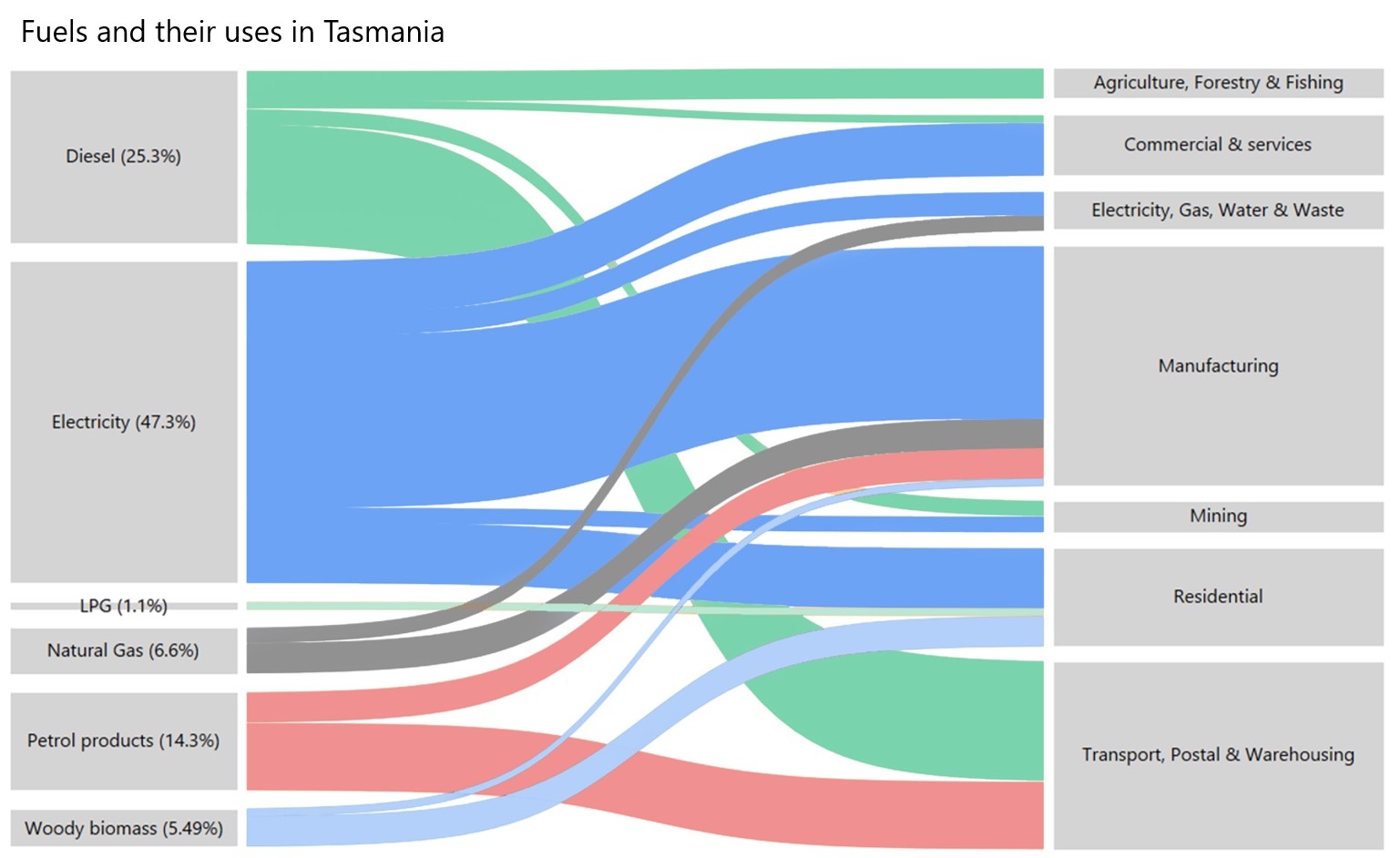
While
petrol use has declined over the last 15 years due to more efficient cars and electric vehicles (EVs),
diesel use has increased because of growing freight volumes, industrial processes, and the popularity of diesel-powered vehicles. That dependency is not only bad for the climate but also poses an energy security risk. Australia has only about
22 days’ supply of diesel and less than a month’s supply of petrol at any one time – and
Tasmania, as an island, is even more vulnerable since all the liquid fuels in the state have to come from overseas or the mainland. In fact, as can be seen in the chart below, the imports of the two fossil fuels are an inverse mirror of each other.
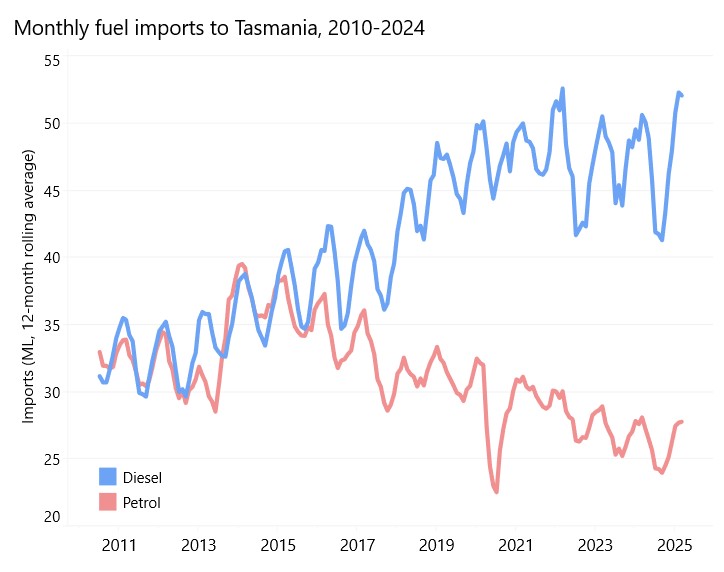
Wait, can't we just electrify?
Electrification is a critical part of our transition – but it can’t do everything. As we highlighted in
PIMBY #9, heavy transport and industry are still hard to electrify with current technologies. And although EVs are getting cheaper and more widely available, they’re not yet a viable option for all Tasmanians. Many
rural and regional Tasmanians still face barriers that keep them from buying an EV as their next car, from limited charging infrastructure to high upfront costs of new vehicles.
And the story gets even more complicated with heavy vehicles, especially those that need to travel long distances in a timely manner. The Clean Energy Finance Corporation
predicts that only 22% of heavy vehicles will be electrified by 2050. There are some battery electric trucks coming onto the market, with some trucks that have a
range of approximately 300km, and some trucks that can take up to three hours to charge. This isn’t practical for long-haul or double-shift operations, such as the trucks that move our food and other products around Tassie.
Industrial energy use poses similar challenges: Tasmania needs more renewable electricity to electrify more sectors – and even now, demand already strains supply. The
Boyer Paper Mill’s recent struggles to switch to electric boilers showed that our renewable power is not yet abundant enough to meet every new demand. The increased renewable electricity coming online under the Tasmanian Renewable Energy Target of reaching 200% will be important here. But the doubling of our renewable electricity output will not happen overnight.
Clean fuels can help fill the gaps and keep industries and freight running while we wait for increased renewable electricity and zero-emissions technologies, such as battery and fuel cell electric trucks, to mature.
What are the advantages of clean fuels?
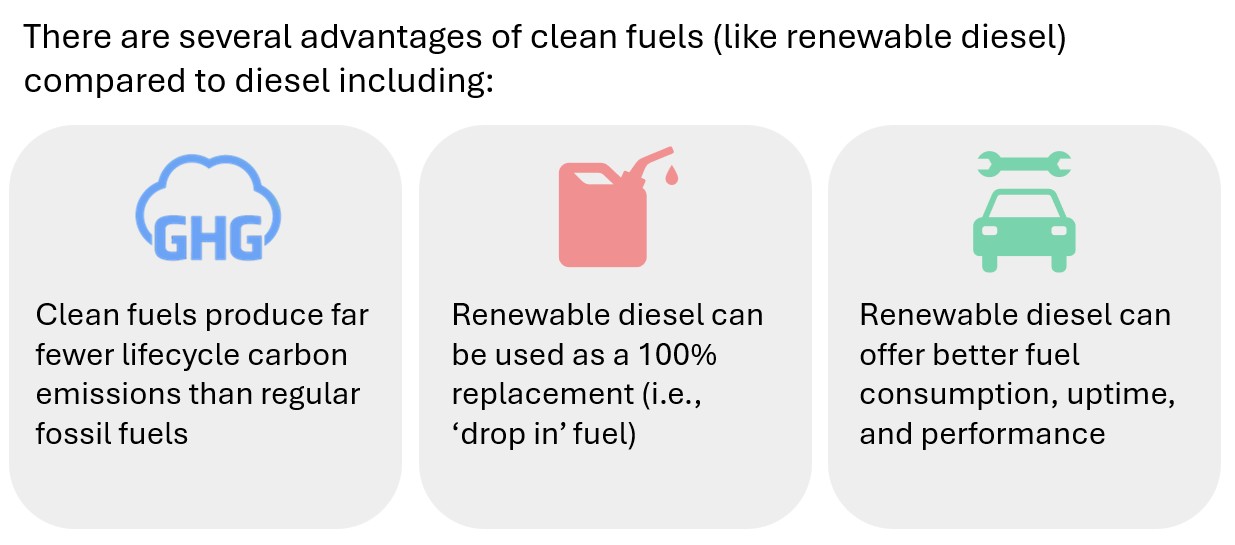
When we consider the difficulties for particular sectors to electrify, clean fuels can offer a lower-emissions pathway. One of their biggest advantages is that they can reduce lifecycle emissions by
up to 90% compared to conventional diesel. This is because the feedstocks used to make the fuel (like waste oils and plant material) absorb carbon emissions during their growth cycle, and/or displace emissions from landfill. This helps
close the carbon loop, substantially lowering the overall emissions profile of transport and industry.
Another major benefit is that renewable diesel as a drop in fuel, is
almost chemically identical to regular diesel. So, it can be used immediately in existing engines, storage tanks and fuel distribution systems without modification. This compatibility means we can avoid developing and rolling out a whole new and costly infrastructure system.
Performance is also proving to be a strong point. Early trials have shown that renewable diesel can improve reliability and reduce maintenance needs.
In Geelong, for example, Cleanaway found that garbage trucks running on HVO100 needed their filters cleaned less often than their trucks using regular diesel.
Last but certainly not least, developing a local clean fuels industry would strengthen Tassie’s energy resilience by reducing our dependence on imported fossil fuels and protect us from global supply disruptions.
And what are the challenges?
Despite their promise, there are some
considerable challenges for clean fuels in Tasmania.

The first is financing and scale. Like many emerging technologies, clean fuels are caught in a classic “chicken and egg” dilemma: producers need reliable demand to justify large-scale investment, but users are reluctant to switch until prices are competitive and supply is stable. Building the necessary supply chains – like feedstock collection, processing, and distribution – will require coordinated investment and clear policy support.
The second, and perhaps greatest, challenge is sustainability – particularly given the scale of production required to phase out fossil fuels. Many of the feedstocks, land and natural resources required to produce clean fuels are already in demand for food production, industrial uses or carbon sequestration. Expanding their use for fuel risks diverting crops and scarce natural resources away from existing needs. If Tassie is to establish a clean fuels industry, it must be at a sustainable scale and adhere to strict environmental and ethical standards to make sure that fuel production doesn’t displace food crops, degrade ecosystems or overuse water resources. There are some
guiding frameworks that can be helpful in figuring out how to manage these risks.
The third challenge is cost. At present, producing renewable diesel costs roughly two and a half times more than refining fossil diesel. To make the two comparable for consumers would require either substantial subsidies or a much higher carbon price than we have today – but we’ll talk more about that in a little bit. The EU’s carbon price sits around
€70 per tonne, but the effective
abatement cost of clean fuels remains over $1,000 per tonne – illustrating just how expensive the transition still is without policy intervention.
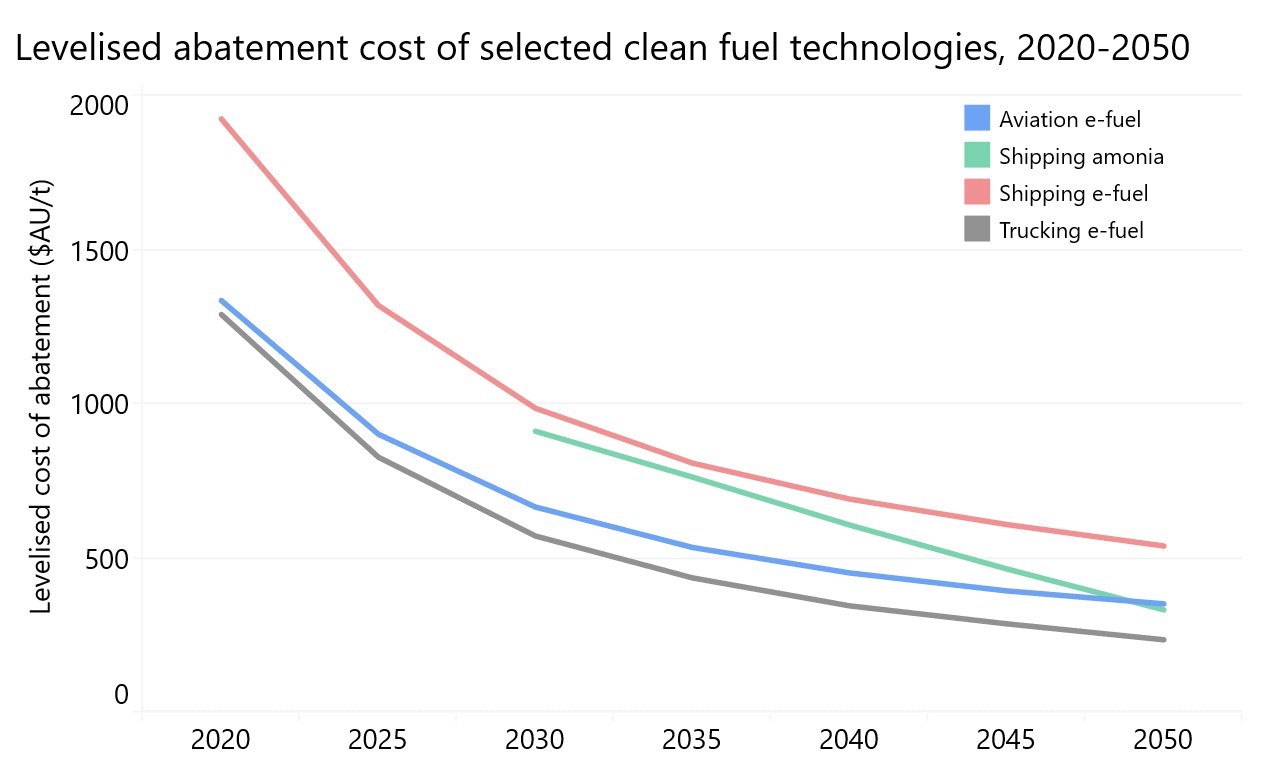
The fourth challenge is about the availability and cost of renewable energy in Tasmania. Given that
existing industries are struggling to get enough renewable electricity to decarbonise, new industries would need to ensure they have additional renewable energy generation to support their needs. If we were to create a clean fuels industry within the state, we would need to carefully consider the appropriate price for electricity, and terms of any long-term supply agreement in an increasingly interconnected National Energy Market. If they were to pay full wholesale price, the cost might make it prohibitive for the industry to get up and running.
With both the advantages and challenges of clean fuels in mind, clean fuels are probably best thought of as a bridge: they will play an important but most likely transitional role in emissions reduction. However, there is another reason why they are not necessarily the be-all, end-all solution to our emissions problem – clean fuels do not dramatically reduce tailpipe emissions. This means that vehicles and industrial processes run on 100% clean fuels will still produce carbon emissions.

Nevertheless, there is no doubt that clean fuels can play an important complementary role in our overall path to reducing emissions and finding more sustainable solutions.
Where do we start in Tasmania?
Recognising that clean fuels will complement and not replace electrification, governments around the world are forecasting that low carbon liquid fuels will be a critical part of the pathway to lower emissions. Australia’s Clean Energy Finance Corporation, for example, predicts that the nation’s heavy road freight fleet will use 6% low carbon liquid fuels by 2030, increasing to 49% by 2050.

To get clean fuels going in Tasmania, government support will be essential. Developers will need carefully designed, sustainable incentives that support investment, help new projects scale, and bring down production costs as the industry matures. The Australian Government has already earmarked funding to help build a clean fuels industry:
- The Future Made in Australia Innovation Fund will invest $250 million in projects that commercialise net-zero technologies, including low-carbon liquid fuels. Applications for this program are expected to open soon.
- The newly announced Cleaner Fuels Program will provide a further $1.1 billion in production incentives for low-carbon liquid fuels, with detailed design work scheduled for late 2025 and applications opening in 2026–27.
But funding alone won’t solve the “chicken and egg” problem. Governments will also need to close the cost gap between clean and conventional fuels to encourage consumers and industries to make the switch. Investors will need long-term price certainty and supply, too – something that mechanisms like long-duration offtake contracts or price guarantees can provide. The
UK is already leading the way here, with their Sustainable Aviation Fuel revenue support mechanism. It demonstrates how to manage price risk and volatility and offers a model for Australia to consider.
Another important part of the discussion is making sure that the benefits from a clean fuels industry is attributable to the producer and/or user here in Australia and Tasmania. The new
Guarantee of Origin Scheme will help with this by allowing fuel producers to reassure users of the low emissions of their products and wider supply chain.
A number of clean fuel projects are already in development across Tasmania, signalling the interest in our state’s potential. The
Bell Bay Powerfuels Project and the
HIF Hampshire Project are two early stage projects that aim to produce replacement fuels for diesel, aviation fuel and gasoline. Then, there’s also the
Westbury BioHub which is focused on turning waste into biomethane, creating value from resources that would otherwise go unused.
These projects go beyond emissions reduction; they also promise economic and regional development opportunities. The
Bell Bay Powerfuels project is expected to employ nearly 500 people during construction and around 150 ongoing positions, contributing an estimated $50 million a year in added value to Tasmania’s economy.
The Westbury BioHub, for its part, aims to establish “a circular economy system that will benefit local communities and deliver significant outcomes for Tasmania.”
These projects are promising, and will create hundreds of jobs especially during the construction phase, but we need to ensure that the clean fuels industry has a domestic focus to support local industry, improve energy security and reduce emissions. Public investment should be linked to local offtake, ensuring that Tasmanian businesses and fleets can access the clean fuels produced here. Above all, all levels of government will have to work collaboratively to establish and shape the industry to deliver sustainable economic and community benefits.
Fuelling the future
The reality is, there isn’t a silver bullet to cut emissions in heavy transport, agriculture and industry. But clean fuels can help us bridge the gap. For Tassie, clean fuels are about more than reducing emissions; they’re a chance to align our energy future with innovation, sustainability, and climate resilience.
The transition is likely already underway. With the right policy settings and investment, Tasmania can turn this transition into an opportunity: creating jobs, strengthening regional economies, and building a more resilient and sustainable, low-carbon energy system. What matters now is making sure that the fuels produced here are done so sustainably and, where possible, used here too – delivering real benefits for Tasmanian people, businesses and communities.
